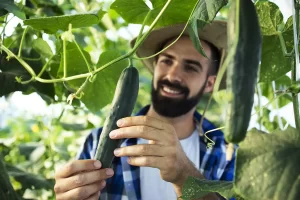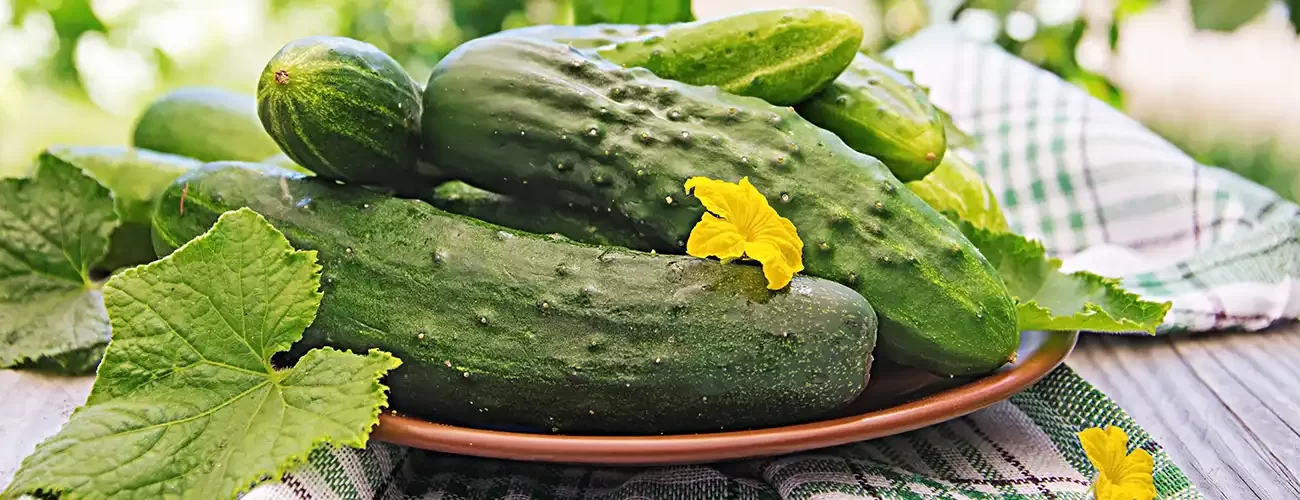No products in the cart.
You should opt for a highly sunny growth location with light and sandy soil to plant and cultivate cucumbers. Place groups of three to four seeds at a depth of 2.5 cm in moist soil to begin planting cucumbers, making careful to leave 40 to 90 cm between seed groups. Read this informative article to find out more about how to plant cucumbers and the ideal growing environments.
Cucumber planting tips
Install the grid support bases and water the cucumber plants once a week when they have started and grown to a height of 3 cm. It is dangerous to plant cucumbers and cultivate them outside during the colder months. Cucumber seedlings have a higher content of soluble carbohydrates and leaf proline when the temperature is lower. These seedling chemicals are frost resistant.
When the temperature decreases, spraying cucumber seedlings twice daily for two days with 200 M methyl jasmonate can enhance the concentration of proline and soluble carbohydrates as well as the amount of chlorophyll in the cucumber.
Glycine betaine for frost resistance of cucumber seedlings
Another osmotic protector that builds up in the plant in response to abiotic stressors is glycine betaine. In cucumber seedlings, this combination efficiently raises growth parameters and boosts resilience to cold shocks above zero degrees. By soaking cucumber seeds in 20 mM glycine betaine, it is possible to produce resistant cucumber seedlings.
In these circumstances, planting cucumbers in plastic tunnels might be a good idea. The phenological stages advance more quickly and the cucumber plant produces more leaves and branches when planted in plastic tunnels without holes. However, in mesh tunnels with 100 1 cm per square meter holes, the leaf surface increases. Because mesh tunnels produce a milder environment than tunnels without holes, they can be a good choice for ripening cucumbers.
The number of times of irrigation in planting cucumbers
Particularly in semi-arid regions, increasing soil water retention and plant productivity from water in the soil are crucial. Use of super absorbents is one of the cost-effective and safe methods. Super absorbents increase the rate and percentage of cucumber seed germination, as well as the plant’s height, water use, and drainage fraction.
When planting cucumbers, the best irrigation period is when only 10% of the soil moisture has been lost. The yield of cucumbers will decline if more than 10% of moisture is lost between two irrigations.
Cucumber fertilization time and schedule
Proper nutrition is one of the crucial and effective factors in the growth of cucumbers. Based on the organic content of greenhouse soil 18, the critical limit of nitrogen is estimated. The nutrition of this plant depends heavily on nitrogen. Nitrogen applied to the leaves of cucumber plants has a greater impact than nitrogen added to the soil on cucumber fruit yield, early ripening, fruit number, plant length, and cucumber plant weight.

What soil does cucumber need?
. Cucumbers cannot be planted in garden soil due to its density and weight. To plant and grow cucumbers in pots, use potting soil or potting mix that has been modified with compost. Cucumbers require fertile, well-drained soil with a pH of neutral for planting.
Fertilizer for rapid growth of cucumbers
The quantitative traits, sugar content, and length of the cucumber plant can all benefit from foliar calcium nitrate spraying at a rate of 10 grams per liter. One of the less essential but crucial nutrients for cucumber growth is zinc. Cucumber exhibits a favorable response with increasing absorbable zinc in the soil in the range of 2.34 to 5.14 to reach 80% of its maximum relative yield.
Although zinc nano-fertilizers can generally have positive effects when used in quantities below 100 mg/kg, when used in excess, they quickly poison plants.
The effect of vermicompost on the growth and yield of cucumber
Fertilizer made from Vermicompost can influence how well iron, zinc, and manganese are absorbed by cucumber aerial organs. Because iron and zinc are more soluble in alkaline soil after fertilizer application, the amount of zinc and iron increases when more than 45 tons of vermicompost fertilizer per hectare is used. Additionally, vermicompost improves calcium, iron, and nitrogen absorption. In greenhouse soil, the critical limits for exchangeable calcium and magnesium are 42 and 15%, respectively. Maintaining the balance between these two elements is crucial for cucumber plants because of the interaction between Calcium and Boron.
Greenhouse cucumber fertilizer program
The greenhouse cucumber responds favorably to an increase in absorbable Boron in the range of 26 to 3.3 mg/kg in order to produce 80% of its maximum yield. Boron’s critical limit is 2 mg/kg. However, it should be noted that consuming too much phosphorus causes the zinc levels in cucumber plants to decrease. All in all, it has been found that applying 3 kg of vermicompost per square meter can increase cucumber fruit yield and nutrient absorption in greenhouse cucumbers by about 20%.
Manganese use in cucumber planting in greenhouses must not exceed 12 mg/kg. Manganese sulfate foliar spraying causes the manganese concentration in treated cucumber leaves to rise. As a result, there are more amino acids present and lysine and methionine are used simultaneously, especially in the new leaves.
As greenhouse vegetable cultivation in Iran expands, it appears necessary to investigate and research methods of increasing yield, including transplanting vegetables. The absorption of soil components can be increased by using different types of pumpkins as a base. It raises the phosphorus and nitrogen content of the cucumber leaves, particularly at the start of the cucumber harvesting season.
